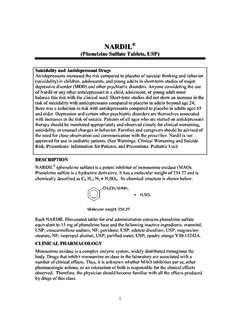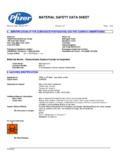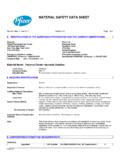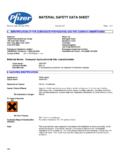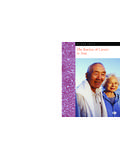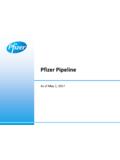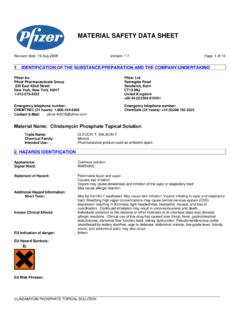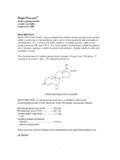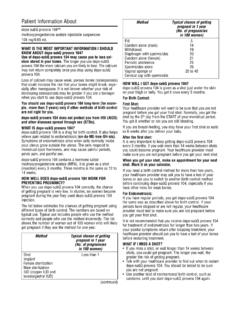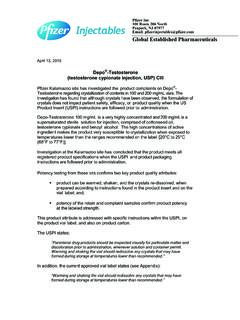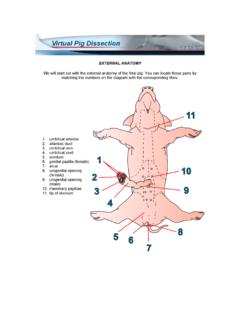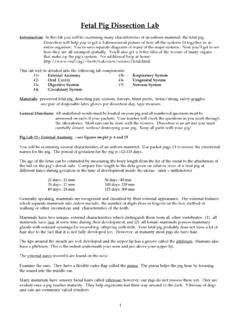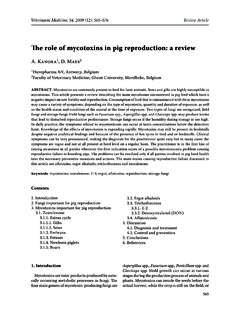Transcription of MATERIAL SAFETY DATA SHEET - Pfizer: One of …
1 Page 1 of 6 Revision date: 05-Jan-2007 MATERIAL SAFETY data SHEET Version: IDENTIFICATION OF THE SUBSTANCE/PREPARATION AND THE COMPANY/UNDERTAKING MATERIAL Name: Benadryl (Diphenhydramine hydrochloride) for Injection Trade Name: Benadryl (R) Chemical Family: Mixture Intended Use: Pharmaceutical product used as antihistamine sedative 2. COMPOSITION/INFORMATION ON INGREDIENTS HazardousIngredientCAS NumberEU EINECS List%Diphenhydramine hydrochloride147-24-0205-687-25 Hydrogen chloride7647-01-0231-595-7**Sodium hydroxide1310-73-2215-185-5** IngredientCAS NumberEU EINECS List%Water for injection7732-18-5231-791-2* Additional Information:** to adjust pH Ingredient(s) indicated as hazardous have been assessed under standards for workplace SAFETY .
2 3. HAZARDS IDENTIFICATION Appearance:Colorless, odorless solution Signal Word:WARNING Statement of Hazard:Harmful if swallowed. Additional Hazard Information: Short Term: Not an eye irritant , Not a skin irritant , Not a skin sensitizer (based on components) . May cause central nervous system effects. Known Clinical Effects: The most common adverse effects seen with the therapeutic use of diphenhydramine HCl include drowsiness, sleepiness, dizziness, sedation, and gastrointestinal disturbance. Higher doses may cause CNS stimulation and/or depression, and impairment of motor and cognitive skills. EU Indication of danger:Not classified pfizer Inc pfizer Pharmaceuticals Group 235 East 42nd Street New York, New York 10017 1-212-573-2222 pfizer Ltd Ramsgate Road Sandwich, Kent CT13 9NJ United Kingdom +00 44 (0)1304 616161 Emergency telephone number:CHEMTREC (24 hours): 1-800-424-9300 Emergency telephone number: ChemSafe (24 hours): +44 (0)208 762 8322 MATERIAL SAFETY data SHEET _____ MATERIAL Name: Benadryl (Diphenhydramine hydrochloride) for InjectionRevision date: 05-Jan-2007 Page 2 of 6 Version.
3 This document has been prepared in accordance with standards for workplace SAFETY , which require the inclusion of all known hazards of the product or its ingredients regardless of the potential risk. The precautionary statements and warnings included may not apply in all cases. Your needs may vary depending upon the potential for exposure in your workplace. 4. FIRST AID MEASURES Eye Contact:Immediately flush eyes with water for at least 15 minutes. If irritation occurs or persists, get medical attention. Skin Contact:Remove contaminated clothing and shoes. Wash skin with soap and water. If irritation occurs or persists, get medical attention. Ingestion:Never give anything by mouth to an unconscious person.
4 Wash out mouth with water. Do not induce vomiting unless directed by medical personnel. Seek medical attention immediately. Inhalation:Remove to fresh air and keep patient at rest. Seek medical attention immediately. 5. FIRE FIGHTING MEASURES Extinguishing Media: Use carbon dioxide, dry chemical, or water spray. Hazardous Combustion Products: May emit toxic fumes of nitrogen oxides and hydrogen chloride. Fire Fighting Procedures: During all fire fighting activities, wear appropriate protective equipment, including self-contained breathing apparatus. Fire / Explosion Hazards: Not applicable 6. ACCIDENTAL RELEASE MEASURES Health and SAFETY Precautions: Personnel involved in clean-up should wear appropriate personal protective equipment (see Section 8).
5 Minimize exposure. Measures for Cleaning / Collecting: Contain the source of spill if it is safe to do so. Collect spill with absorbent MATERIAL . Clean spill area thoroughly. Measures for Environmental Protections: Place waste in an appropriately labeled, sealed container for disposal. Care should be taken to avoid environmental release. Additional Consideration for Large Spills: Non-essential personnel should be evacuated from affected area. Report emergency situations immediately. Clean up operations should only be undertaken by trained personnel. 7. HANDLING AND STORAGE General Handling: Use appropriate ventilation. Avoid breathing vapor or mist. Avoid contact with skin and clothing.
6 Storage Conditions: Store as directed by product packaging. 8. EXPOSURE CONTROLS / PERSONAL PROTECTION pfizer OEL TWA-8 Hr: mg/m , (as free base)Diphenhydramine hydrochloride MATERIAL SAFETY data SHEET _____ MATERIAL Name: Benadryl (Diphenhydramine hydrochloride) for InjectionRevision date: 05-Jan-2007 Page 3 of 6 Version: The exposure limit(s) listed for solid components are only relevant if dust or mist may be generated. Analytical Method: Analytical method available for Diphenhydramine. Contact pfizer Inc for further information. Engineering Controls: Engineering controls should be used as the primary means to control exposures. Local and general ventilation should be used as necessary, when handling this MATERIAL in bulk.
7 Personal Protective Equipment: Hands:Rubber gloves Eyes: SAFETY glasses or goggles Skin:Wear protective clothing when working with large quantities. Respiratory protection:If the applicable Occupational Exposure Limit (OEL) is exceeded, wear an appropriate respirator with a protection factor sufficient to control exposures to below the OEL. 9. PHYSICAL AND CHEMICAL PROPERTIES: Solubility:Soluble: WaterpH: Point ( C):100 Vapor Pressure (kPa) (20 C)Relative Flash Point (Liquid) ( C):>61 10. STABILITY AND REACTIVITY Stability:Stable under normal conditions of use. Conditions to Avoid:None knownIncompatible Materials:As a precautionary measure, keep away from strong oxidizers.
8 Hazardous Decomposition Products:None known Polymerization:Will not occur 11. TOXICOLOGICAL INFORMATION General Information:The information included in this section describes the potential hazards of the individual ingredients. Hydrogen chloridePhysical State: Sterile solution OSHA - Final PELS - TWAs:Color:Colorless2 mg/m Odor:OdorlessMolecular Formula: MixtureMolecular Weight:Mixture ACGIH Ceiling Threshold Limit:= 2 mg/m3 Ceiling ACGIH Ceiling Threshold Limit:= 2 ppm Ceiling Australia PEAK = 2 mg/m3 Peak Australia PEAK = 5 ppm Peak = mg/m3 PeakSodium hydroxide MATERIAL SAFETY data SHEET _____ MATERIAL Name: Benadryl (Diphenhydramine hydrochloride) for InjectionRevision date: 05-Jan-2007 Page 4 of 6 Version: Toxicity: (Species, Route, End Point, Dose) Irritation / Sensitization.
9 (Study Type, Species, Severity) Repeated Dose Toxicity: (Duration, Species, Route, Dose, End Point, Target Organ)Reproduction & Development Toxicity: (Duration, Species, Route, Dose, End Point, Effect(s)) Liver Central nervous system Genetic Toxicity: (Study Type, Cell Type/Organism, Result) Carcinogenicity: (Duration, Species, Route, Dose, End Point, Effect(s))13 Week(s) Rat Oral 310 mg/kg/day LOAEL LiverGuinea Pig Oral LD50 284 mg/kgMouse Oral LD50 900 mg/kg2 Year(s) Rat Oral 15 mg/kg/day NOAEL LiverHydrogen chloride2 Year(s) Mouse Oral 21 mg/kg/day NOAEL LiverHuman Oral LDmin. mg/kgSodium hydroxideSodium hydroxideDiphenhydramine hydrochlorideEmbryo / Fetal Development Rat Oral 100 mg/kg/day NOAEL Not teratogenic, Maternal toxicity, FetotoxicityEye Irritation Rabbit SevereEmbryo / Fetal Development Mouse Oral 80 mg/kg/day NOAEL Not Teratogenic, Maternal Toxicity, FetotoxicityMouse IP LD50 40 mg/kgEmbryo / Fetal Development Rat Oral 50 mg/kg/day NOAEL Not Teratogenic, Maternal Toxicity, FetotoxicityRat Inhalation LC50 1H 3,124 ppmSkin Irritation Rabbit SevereDiphenhydramine hydrochlorideDiphenhydramine hydrochlorideBacterial Mutagenicity (Ames)
10 Salmonella NegativeDiphenhydramine hydrochlorideIn Vitro Mammalian Cell Mutagenicity Mouse Lymphoma NegativeEye Irritation Rabbit Non-irritatingIn Vitro Chromosome Aberration Chinese Hamster Ovary (CHO) cells Positive without activation Negative with activationIn Vitro Sister Chromatid Exchange Chinese Hamster Ovary (CHO) cells NegativeSkin Sensitization - Beuhler Guinea Pig NegativeIn Vitro Unscheduled DNA Synthesis Rat Hepatocyte NegativeRat Oral LD50 500 mg/kgMouse Inhalation LC50 1H 1,108 ppmSkin Sensitization - LLNA Mouse NegativeDiphenhydramine hydrochloride2 Year(s) Rat Oral 15 mg/kg/day NOAEL Not carcinogenicMouse Oral LD50 114 mg/kgDiphenhydramine hydrochloride MATERIAL SAFETY data SHEET _____ MATERIAL Name: Benadryl (Diphenhydramine hydrochloride) for InjectionRevision date: 05-Jan-2007 Page 5 of 6 Version: Carcinogen Status: None of the components of this formulation are listed as a carcinogen by IARC, NTP or OSHA.
